A Fitted Numerical Approach for Singularly Perturbed Two-Parameter Parabolic Problem with Time Delay
Abstract
This paper is aimed at constructing and analyzing a fitted approach for singularly perturbed time delay parabolic problems with two small parameters. The proposed computational scheme comprises the implicit Euler and especially finite difference method for the time and space variable discretization, respectively, on uniform step size. The stability and convergence analysis of the method is provided and is first-order parameter uniform convergent. Further, the numerical results depict that the present method is more convergent than some methods available in the literature.
1. Introduction
The nature of Equation (1) changes based on the values of perturbations ε and μ. If μ = 0, then the problem is reaction-diffusion type [3] and boundary layers exhibit near s = 0 and s = 1 of width . If μ = 1, then the problem is convection-diffusion type [4, 5] and boundary layers exhibit near s = 0 of width O(ε). These problems have several fascinating phenomena in lubrication theory [6] and chemical flow reactor theory [7, 8]. When 0 ≤ μ ≤ 1, problem (1) is modelling different phenomena in applied sciences and engineering, for instance, problems found in control theory [9], mechanical systems, population dynamics in the biosciences [10], and heat and mass transfer in chemical engineering [11].
Various parameter uniform numerical methods for singularly perturbed parabolic problems with two parameters without time lag are suggested by several scholars. For instance, the authors in [12] developed robust nonstandard finite difference method based on Micken’s type discretization rule for spatial discretization and the implicit finite difference method for temporal discretization for singularly perturbed parabolic problems with two parameters. The researchers in [13, 14] suggested parameter uniform numerical methods using finite difference schemes with fitted techniques to solve singularly perturbed two parametric parabolic problems. In article [15], the authors developed a fitted mesh cubic spline in tension for singularly perturbed problems with two parameters. [16] suggested a uniformly convergent computational scheme which consists of the Crank-Nicholson method to discretize the time variable and the central difference approximation on the nonstandard methodology of Mickens for the space variable for Equation (58). Quadratic B-spline collocation method on exponentially graded mesh for two-parameter singularly perturbed problem is presented by [17]. An implicit computational method on a predefined Shishkin mesh is presented for solving two-parameter parabolic singularly perturbed boundary value problems with nonsmooth data by [18]. [19] suggested parameter uniform finite element method for two-parameter singularly perturbed parabolic reaction-diffusion problems. [20] developed nonstandard finite difference method on uniform mesh for two-parameter singular perturbation problem.
The authors in papers [21, 22] developed uniform numerical methods for a singularly perturbed reaction-convection-diffusion equation in one dimension with a discontinuous source term. In articles [23–25], the authors have developed robust numerical methods for singularly perturbed time delay parabolic problems with two parameters based on adaptive layer mesh methods. However, exponentially fitted difference (EFD) schemes have gained popularity as a powerful technique to solve boundary value problems. For instance, the authors in [26–28] suggested different EFD schemes for singularly perturbed two-point boundary value problems.
Nevertheless, the solution methodologies for singularly perturbed time delay parabolic problems with two parameters are at a primarily stage and need a lot of investigation. Therefore, to diminish the gap observed, we proposed a novel parameter uniform numerical approach formulated based on uniform mesh implicit Euler approximation for time variable and especially finite difference method for the spatial variable. The novelty of the presented method, unlike the Shishkin and Bakhvalov mesh types, does not require a priori information about the location and width of the boundary layer.
2. Properties of Continuous Solution
Lemma 1 (minimum principle). Suppose w|∂∇ ≥ 0 and , then .
Proof (see [24].)An immediate consequence of minimum principle above for the solution of Equation (1) provides the next Lemma 2.
Lemma 2 (uniform stability estimate). Let w(s, t) be the solution of problem (1); then, we have
3. Construction of the Numerical Scheme
3.1. Temporal Semidiscretization
Clearly, the operator achieves the maximum principle, which confirms the stability of the semidiscrete (4).
The local truncation error (LTE) devoted in the semidiscrete scheme is the difference between the analytical solution w(s, tj+1) and the estimate solution W(s, tj+1) of Equation (4), i.e., (LTE)j+1 = w(s, tj+1) − W(s, tj+1), and the global error Ej+1 is the contribution of the local error up to the (j + 1)th time level. The bound of error for the semidiscrete scheme is estimated as follows.
Lemma 3 (LTE). If , then the LTE in the temporal direction gratifies
Proof. Using Taylor’s series expansion for w(s, tj−1), we have
This implies
Substituting Equation (1) into Equation (7), we have
Subtracting Equation (4) from Equation (8), the local truncation error (LTE)j+1 = w(s, tj+1) − W(s, tj+1) at (j + 1)th is the solution of a boundary problem
Hence, using the maximum principle on the operator provides
Lemma 4 (global error estimate (GEE)). Under the hypothesis of Lemma 3, the GEE in the temporal direction is given by
3.2. Spatial Semidiscretization
For small mesh sizes, the above matrix is (i.e., the matrix is diagonally dominant) and nonsingular. Hence, by [31], the matrix ϑ is M-matrix and the system of equations can be solved by matrix inverse with the given boundary conditions.
4. Convergence Analysis
Lemma 5. The matrix associated with the discrete scheme (33) is M-matrix.
Proof. By assuming that a(s) = A and q(s) = B are constant functions in [0, 1], where A and B are arbitrary constants, one can easily see that the inequalities , , , , and are satisfied under the assumptions that (a(s) = A) > 0, (q(s) = B) > 0, and (A/2Δs + B/30) < σ(ρ)ε/Δs2. Therefore, the matrix associated with the discrete scheme (33) is M-matrix.
Lemma 6 (discrete maximum principle). Assume that the discrete function gratifies on i = 0, N. Then, on implies that at each point of .
Lemma 7. The solution of the discrete scheme in (33) on gratifies the following estimate:
Hence, Lemma 7 depicts that the scheme in Equation (33) is stable in supremum norm.
Lemma 8. If W ∈ C3(I), then the LTE in space discretization is written as
Proof. By definition
Using the relation (33) with W = (μa(0)/2)coth(μa(1)ρ/2) we get,
Thus, the desired result is obtained.
Lemma 9. Let W(si, tj+1) be the solution of problem (13) and be the solution of the discrete problem (33). Then, the following estimate is obtained:
Proof. Rewrite Equation (33) in matrix vector form as
From Equations (40) and (43), we get
Thus, the error equation is
Since 0 < ε ≪ 1, for sufficiently small Δs, the matrix W is irreducible and monotone. Then, it follows that Y−1 exists, and its elements are nonnegative [32]. Hence, from Equation (45), we obtain
Let be the (ki)th elements of Y−1. Since by the definition of multiplication of matrices with its inverses, we have
Therefore, it follows that
Therefore,
Theorem 10. Let w(s, t) be the solution of the problem (1) and be the numerical solution obtained by the proposed scheme (33). Then, for sufficiently small Δs, the error estimate for the totally discrete scheme is given by
5. Numerical Examples, Results, and Discussions
Example 1 (see [24].)Consider
Example 2 (see [24].)Consider
The validation of the theoretical findings is carried out by considering two examples whose , , EN,M, and rN,M are plotted in Tables 1 and 2. From these tables, one can see that as ε⟶0 and μ = 10−3, the error goes constant. Moreover, as the mesh size decreases, the order of convergence goes to one, and the maximum absolute error decreases. These reveal that the solution of the proposed method converges parameter uniformly with the order of convergence in good agreement with the theoretical findings.
| εN⟶ | 25 | 26 | 27 | 28 | 29 | 210 |
|---|---|---|---|---|---|---|
| ↓M⟶ | 23 | 24 | 25 | 26 | 27 | 28 |
| Proposed scheme | ||||||
| 10-0 | 7.3516e-03 | 5.7683e-03 | 3.6428e-03 | 2.1296e-03 | 1.1630e-03 | 6.0953e-04 |
| 3.4991e-01 | 6.6310e-01 | 7.7447e-01 | 8.7273e-01 | 9.3208e-01 | ||
| 10-2 | 1.9343e-02 | 1.0465e-02 | 5.4599e-03 | 2.7902e-03 | 1.4107e-03 | 7.0935e-04 |
| 8.8624e-01 | 9.3863e-01 | 9.6851e-01 | 9.8396e-01 | 9.9184e-01 | ||
| 10-4 | 1.9854e-02 | 1.0658e-02 | 5.5313e-03 | 2.8189e-03 | 1.4231e-03 | 7.1502e-04 |
| 8.9749e-01 | 9.4625e-01 | 9.7249e-01 | 9.8610e-01 | 9.9298e-01 | ||
| 10-6 | 1.9860e-02 | 1.0660e-02 | 5.5318e-03 | 2.8190e-03 | 1.4231e-03 | 7.1503e-04 |
| 8.9766e-01 | 9.4639e-01 | 9.7257e-01 | 9.8615e-01 | 9.9296e-01 | ||
| 10-8 | 1.9861e-02 | 1.0661e-02 | 5.5327e-03 | 2.8195e-03 | 1.4234e-03 | 7.1518e-04 |
| 8.9760e-01 | 9.4629e-01 | 9.7254e-01 | 9.8610e-01 | 9.9296e-01 | ||
| 10-10 | 1.9861e-02 | 1.0661e-02 | 5.5327e-03 | 2.8195e-03 | 1.4234e-03 | 7.1518e-04 |
| 8.9760e-01 | 9.4629e-01 | 9.7254e-01 | 9.8610e-01 | 9.9296e-01 | ||
| 10-12 | 1.9861e-02 | 1.0661e-02 | 5.5327e-03 | 2.8195e-03 | 1.4234e-03 | 7.1518e-04 |
| 8.9760e-01 | 9.4629e-01 | 9.7254e-01 | 9.8610e-01 | 9.9296e-01 | ||
| EN,M | 1.9861e-02 | 1.0661e-02 | 5.5327e-03 | 2.8195e-03 | 1.4234e-03 | 7.1518e-04 |
| rN,M | 8.9760e-01 | 9.4629e-01 | 9.7254e-01 | 9.8610e-01 | 9.9296e-01 | |
| Results in [24] | ||||||
| EN,M | 4.3705e-2 | 1.6704e-2 | 7.3802e-3 | 3.7406e-3 | 1.8967e-3 | 9.5511e-4 |
| rN,M | 1.3876 | 1.1785 | 9.803e-01 | 9.797e-01 | 9.898e-01 | |
| εN⟶ | 25 | 26 | 27 | 28 | 29 | 210 |
|---|---|---|---|---|---|---|
| ↓M⟶ | 23 | 24 | 25 | 26 | 27 | 28 |
| Proposed scheme | ||||||
| 10-0 | 3.9899e-04 | 2.0538e-04 | 1.0431e-04 | 5.2577e-05 | 2.6397e-05 | 1.3226e-05 |
| 9.5806e-01 | 9.7742e-01 | 9.8837e-01 | 9.9406e-01 | 9.9700e-01 | ||
| 10-2 | 3.7603e-03 | 1.9594e-03 | 9.9849e-04 | 5.0406e-04 | 2.5324e-04 | 1.2692e-04 |
| 9.4044e-01 | 9.7259e-01 | 9.8615e-01 | 9.9309e-01 | 9.9659e-01 | ||
| 10-4 | 4.5642e-03 | 2.3635e-03 | 1.2012e-03 | 6.0550e-04 | 3.0394e-04 | 1.5227e-04 |
| 9.4944e-01 | 9.7645e-01 | 9.8828e-01 | 9.9434e-01 | 9.9715e-01 | ||
| 10-6 | 4.5778e-03 | 2.3685e-03 | 1.2040e-03 | 6.0687e-04 | 3.0463e-04 | 1.5261e-04 |
| 9.5068e-01 | 9.7614e-01 | 9.8838e-01 | 9.9433e-01 | 9.9721e-01 | ||
| 10-8 | 4.5773e-03 | 2.3682e-03 | 1.2038e-03 | 6.0679e-04 | 3.0458e-04 | 1.5259e-04 |
| 9.5071e-01 | 9.7620e-01 | 9.8833e-01 | 9.9438e-01 | 9.9716e-01 | ||
| 10-10 | 4.5773e-03 | 2.3682e-03 | 1.2038e-03 | 6.0679e-04 | 3.0458e-04 | 1.5259e-04 |
| 9.5071e-01 | 9.7620e-01 | 9.8833e-01 | 9.9438e-01 | 9.9716e-01 | ||
| 10-12 | 4.5773e-03 | 2.3682e-03 | 1.2038e-03 | 6.0679e-04 | 3.0458e-04 | 1.5259e-04 |
| 9.5071e-01 | 9.7620e-01 | 9.8833e-01 | 9.9438e-01 | 9.9716e-01 | ||
| EN,M | 4.5778e-03 | 2.3685e-03 | 1.2040e-03 | 6.0687e-04 | 3.0463e-04 | 1.5261e-04 |
| rN,M | 9.5068e-01 | 9.7614e-01 | 9.8838e-01 | 9.9433e-01 | 9.9721e-01 | |
| Results in [24] | ||||||
| EN,M | 1.1161e-2 | 5.1087e-3 | 2.4749e-3 | 1.2214e-3 | 6.0706e-4 | 3.0264e-4 |
| rN,M | 1.1274 | 1.0455 | 1.0188 | 1.0086 | 1.0042 | |
For several values of ε and μ, the numerical solutions for Examples 1 and 2 are plotted in Figures 1 and 2, respectively. These figures depict that the solution to the problem under consideration exhibits a parabolic type boundary layer. To show the relationship between the space variable and the solution, we have used the log-log plot in Figure 3 which is a straight line. This shows that the solution changes as a power of the space variable and confirms the first-order uniform convergence of the proposed method.
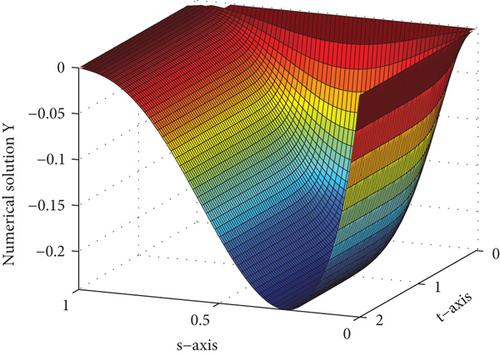
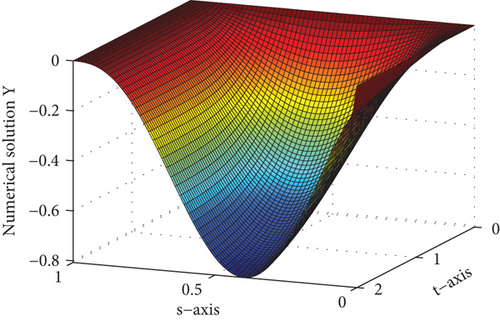
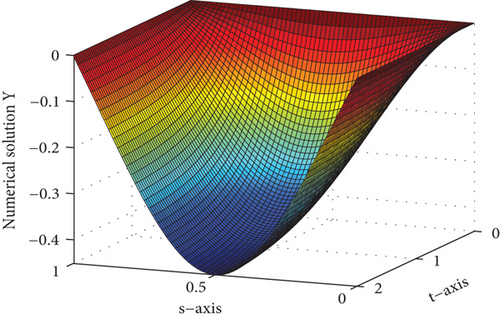
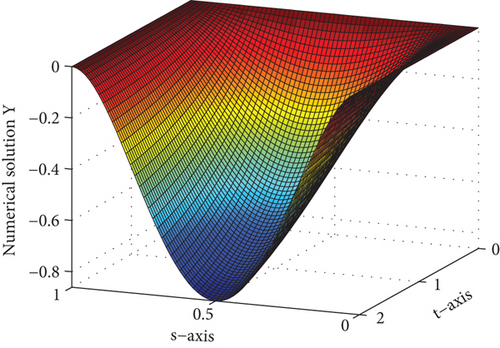
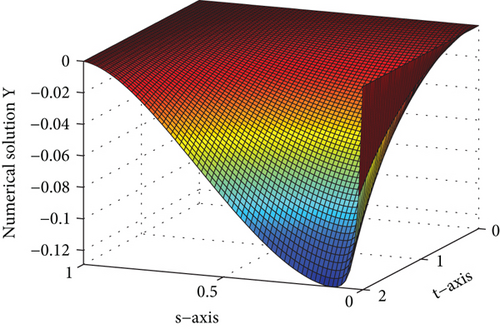
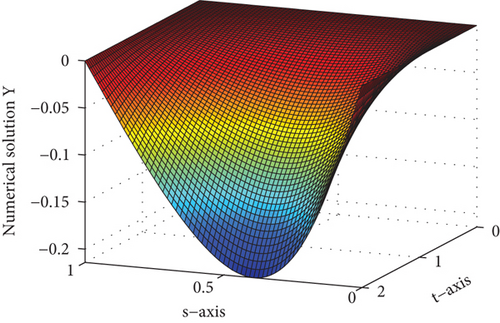
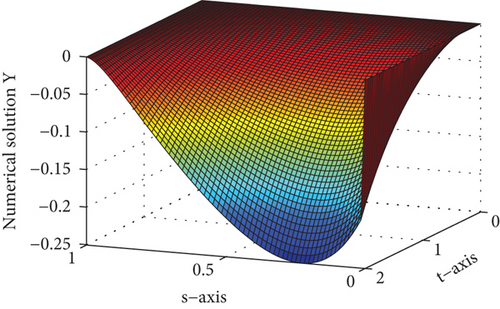
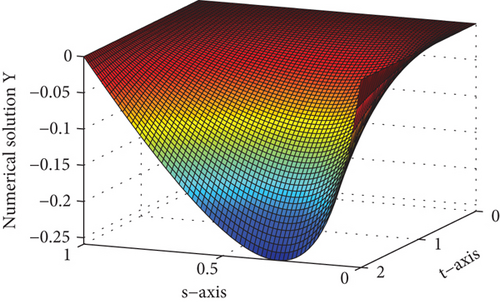
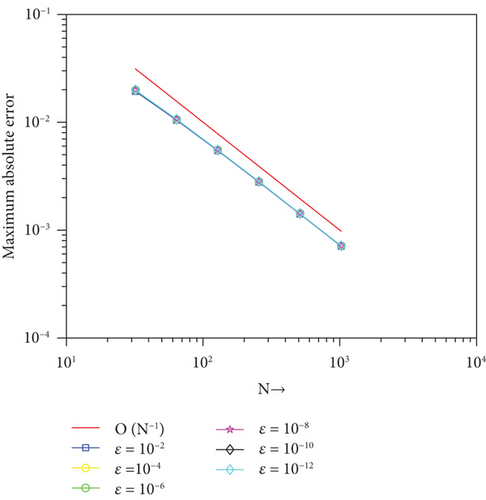
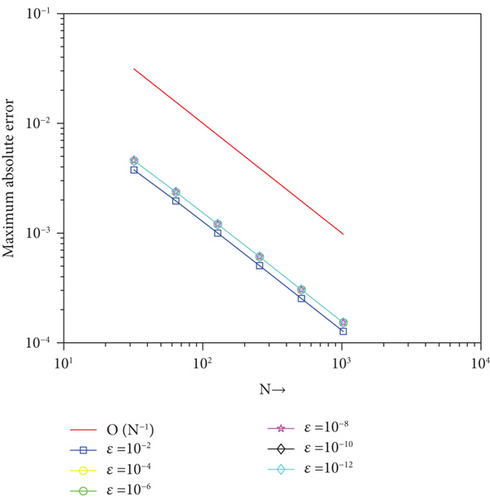
6. Conclusion
A parameter uniform convergent numerical scheme for singularly perturbed two parametric parabolic problem with time lag is presented. The proposed numerical scheme comprises the implicit Euler method and novel finite difference method in the time and space directions, respectively. Parameter uniform convergence analysis of the scheme is investigated theoretically as well as numerically. The obtained results show that the presented scheme gives better accuracy than the existing schemes. The presented scheme is accurate and convergent with the order of convergence O(Δt + Δs2).
Conflicts of Interest
The authors declared no potential conflicts of interest concerning the research, authorship, and publication of this article.
Open Research
Data Availability
No data were used to support this study.




